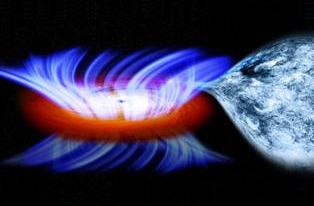|
|||||||||||||||||
|
|
|
|||
|
Stellar Mass Black
Hole, Record Breaking Wind Moving About 20 Million MPH By Shane Nolan |
||||
 |
February 22, 2012 - Astronomers using NASA's Chandra
X-ray Observatory have clocked the fastest wind yet
discovered blowing off a disk around a stellar-mass
black hole. This result has important implications for
understanding how this type of black hole behaves.
The record-breaking wind is moving about 20 million mph,
or about 3 percent of the speed of light. This is nearly
10 times faster than had ever been seen from a
stellar-mass black hole.
Stellar-mass black holes are born when extremely massive
stars collapse. They typically weigh between five and 10
times the mass of the sun. The stellar-mass black hole
powering this super wind is known as IGR J17091-3624, or
IGR J17091 for short.
|
|||
|
"This is
like the cosmic equivalent of winds from a category five
hurricane," said Ashley King from the University of Michigan,
lead author of the study published in the Feb. 20 issue of The
Astrophysical Journal Letters. "We weren't expecting to see such
powerful winds from a black hole like this."
The wind
speed in IGR J17091 matches some of the fastest winds generated
by supermassive black holes, objects millions or billions of
times more massive.
"It's a
surprise this small black hole is able to muster the wind speeds
we typically only see in the giant black holes," said co-author
Jon M. Miller, also from the University of Michigan. "In other
words, this black hole is performing well above its weight
class."
Another
unanticipated finding is that the wind, which comes from a disk
of gas surrounding the black hole, may be carrying away more
material than the black hole is capturing. "Contrary to the
popular perception of black holes pulling in all of the material
that gets close, we estimate up to 95 percent of the matter in
the disk around IGR J17091 is expelled by the wind," King said.
Unlike winds from hurricanes on Earth, the wind from IGR J17091 is blowing in many different directions. This pattern also distinguishes it from a jet, where material flows in highly focused beams perpendicular to the disk, often at nearly the speed of light. |
||||


